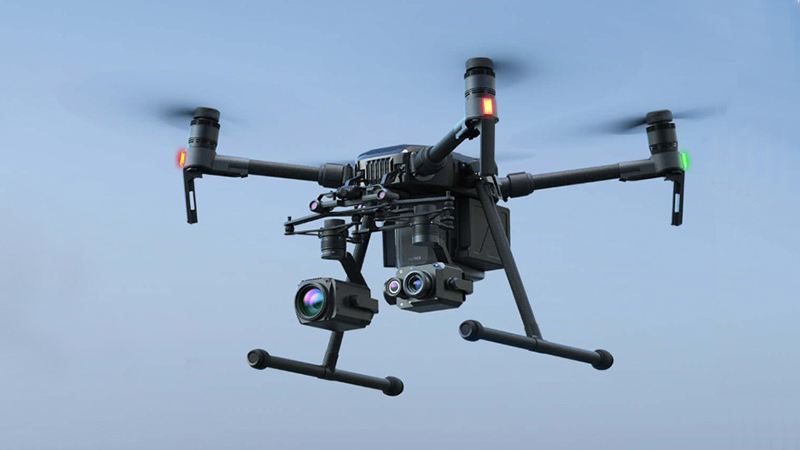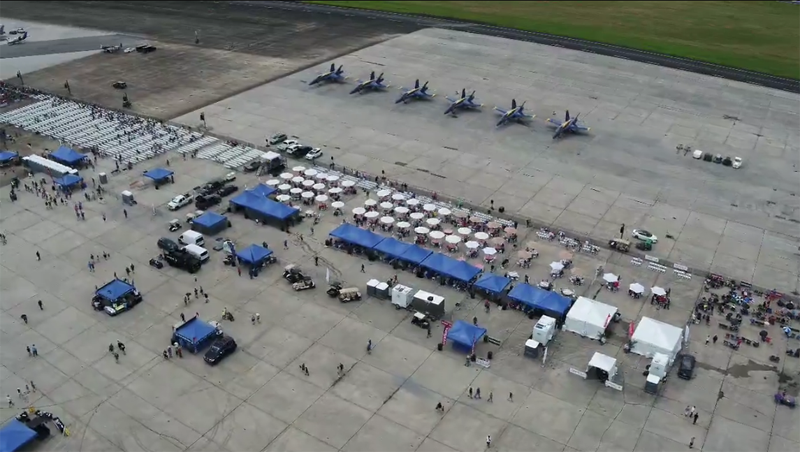Want to fly a drone at your air show? It’s a great way to improve the show experience for attendees and everyone else involved, particularly in terms of better traffic management and safety. However, it’s still not easy to get permission to fly a drone at an air show.
But it’s not impossible.
Recently, AttendStar worked with StormPoint, a non-profit that uses drones for search and rescue and emergency services support, to fly a drone at the Great Tennessee Air Show (GTAS) in Smyrna, Tennessee.
After much strategic coordination, Russell Bradshaw, Executive Director of StormPoint, and his StormPoint colleague, Jeff Clementi, who is also the UAS Specialist for Rutherford County Fire and Rescue in Tennessee, successfully flew a DJI Matrice 210 v2 at GTAS in June.

Why Fly Drones at Air Shows
There are five strategic reasons why air shows should use drones:
- Better logistics and attendee experience
- Improved safety
- Creative promotional opportunities during the show
- More marketing opportunities after the show
- Increased last-minute attendees
Let’s take a closer look at each one of these strategic reasons:
1. Better Logistics and Attendee Experience
Drones can give show organizers a bigger view of everything that’s happening at an air show in real-time. From traffic management to crowd control, when the logistics of navigating an event are optimized, attendees will be happier.
Air shows can respond faster to traffic and crowd problems when it’s easy to see what’s happening across the venue at all times.
2. Improved Safety
Flying drones at an air show can support local law enforcement, EMS, and airport fire and rescue services in their situational awareness efforts during the event by providing information that helps with crowd monitoring, traffic management, and responding to calls for help, which may include missing children, medical emergencies related to the heat at the outdoor event, or security concerns.
Not only does this information allow emergency personnel to perform their jobs better, it also gives attendees peace of mind that problems will be identified and dealt with quickly.
3. More Promotional Opportunities during the Show
Drones can capture photos and videos as well as live stream footage during an air show that can be used for real-time promotions.
For example, photos and videos can quickly be posted on the show’s Facebook and Instagram accounts to elicit the fear of missing out (FOMO) and maintain the momentum of word-of-mouth marketing. These efforts can lead to higher attendance for the current show and pre-promotion for future shows.
4. More Marketing Opportunities after the Show
Every air show team knows their work isn’t done when a show ends. Instead, it’s time to start preparing for the next show, and that includes early marketing. If a drone was used at the recent show and captured images and videos, those assets can be used in a wide variety of marketing campaigns such as:
- Social media posts
- Social media ads
- Blog posts
- Brochures
- Online and offline ads
- Email marketing
- Banners, posters, flyers, and billboards
- Direct mail
- And more
Visual content matters when you’re promoting an event, and when you can get great-looking, professional images from a drone to enhance your ads and marketing materials, they’re even better!
5. Increased Last-Minute Attendees
Live streaming an air show using a drone isn’t just cool. It can also make your event more successful.
Imagine someone sees the live stream of their local air show on Facebook. They just might decide to head over to the show with friends and family or tell other people about it, which could mean higher attendance for you and the potential for more revenue through added ticket and ancillary sales.

Getting Permission to Fly Drones at Air Shows
Flying drones at air shows is still new, so getting permission from the show, the airport, and the Federal Aviation Authority (FAA) isn’t easy.
“Getting permission was a challenge for us,” Russell explains. “Not because it was impossible but because it’s a very uncommon request that many people, including our drone pilots and even the FAA, haven’t approached before.”
Fortunately for AttendStar and StormPoint, the local FAA, GTAS Air Boss Wayne Boggs, the airport fire chief, and Airport Director John Black were all very open to the idea and extremely helpful in making it happen.
“Flying a drone at GTAS was an idea that came from AttendStar’s Gary Bradshaw,” shares Russell. “Ticketing for the show was being done through AttendStar’s ticketing platform, and Gary had the idea to fly a drone at the show. AttendStar’s team enjoys trying new ideas and technology at events, and Gary believed that drones could improve the experience for attendees and help air shows be more successful.
“AttendStar is in a unique position. They’re in contact with so many different air shows around the country and are involved in many different ways at each show. They’re always talking to airport managers, show performers, food vendors, military coordinators, and marketing teams. They knew everyone we needed to talk to, and because they’ve been involved with hundreds of air shows, they knew exactly what problems existed and what a drone might be able to help with.
“Gary had already discussed the idea with Airport Director John Black before he mentioned it to us. It was an idea that John was surprised to be asked about, but we met with him, and he approved for us to keep moving forward with the idea to see if it was possible.”
Keep in mind, getting permission from the Airport Director doesn’t mean you’ll be able to fly a drone at your next air show. There are more permissions you need to get, and you need a solid plan and team to do it.
“The final decision will be made by the Air Boss or the owner of the TFR,” says Russell. “Be ready for objections from all sides. There are a lot of misconceptions about drones out there, and you’re going to meet some people who don’t like the idea or don’t know the rules.
“I approached Wayne Boggs who was the Air Boss for GTAS, and he was very open to the idea of flying a drone during the show,” says Russell. “He asked a few questions about where we wanted to fly and at what altitude. Once he realized we knew what we were talking about and had a plan, he had no objections.”
Of course, the entire plan would collapse if the FAA didn’t get on board. “The local FAA office was very helpful,” Russell shares, “and I’d even say they were excited to help us fly at the show and do everything legally and safely.”
Once all of the necessary permissions were obtained, StormPoint was required to work closely with the air show. “The FAA, the Air Boss, and the airport Fire Chief all required us to be present every morning at the Pilot’s Briefing,” Russell explains. “It was an incredible experience being in that room with the Blue Angels and other well-known performers and pilots. It was very clear that we, as the drone pilots, would be held to the same high standards as everyone else in the air at the show.”
Taking Flight
Drone pilots at air shows are flying for commercial purposes and must have a Part 107 Remote Pilot Certificate, which Russell warns will be verified by the FAA.
Determining the type of drone to fly depends on your goals for using it. Based on the goals for the GTAS, StormPoint flew a DJI Matrice 210 v2, which was chosen for its advanced capabilities, such as carrying two cameras at once and having built-in anti-collision strobe lighting for safety.
Russell warns, “Keep in mind that many modern drones are programmed not to allow takeoff close to an airport. Manufacturers like DJI will require an official letter showing that you have permission to fly inside of this area before they will help you unlock the drone to fly there.”
Key Takeaways
Drones can be leveraged in so many ways by air shows. Russell says, “What StormPoint has learned from using drones previously during emergency incidents is they can provide incredible information that can have so many different uses from planning to real-time decision-making and effective marketing with captured images, videos, and live streams for promotional use.”
The only way to be successful is to focus on planning and coordination. “Just like every other piece of an air show, you have to be able to show that you’re prepared and that you can accomplish the task safely,” Russell explains. “The planning for these shows starts up to a year in advance, and the earlier you can start adding a drone into the planning conversation, the easier it’s going to be.
Get Help
You can learn more about StormPoint on its Facebook Page.
If you need help with your event ticketing or event marketing, call AttendStar at (615-223-1973) or submit the Contact Us Form.



